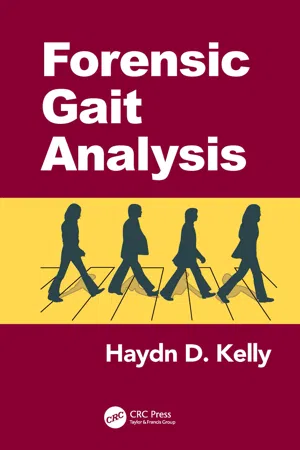
- 342 pages
- English
- ePUB (mobile friendly)
- Available on iOS & Android
Forensic Gait Analysis
About This Book
Forensic Gait Analysis examines the inter-section of podiatric medicine with forensic investigation—that which links or dissociates a suspect to a crime through analysis of their gait, that is their movement—how an individual walks, runs, and bends.
This book provides a concise explanation of how an individual's gait and biomechanics are forensically analysed and compared, using video imagery in the process of human identification and investigations. Along with the presentation and delivery of material with case law references illustrating the use of expert evidence.
Gait analysis is a long-standing component of the diagnostic and therapeutic tool set of medical disciplines, although the knowledge goes back much further.
The area has also captured the interest of technology engineers and others, as the development and use of forensic gait analysis as an investigative and evidential device continues to widen.
Features:
• Presents succinct knowledge on forensic gait analysis.
• 100+ illustrations with photographs and diagrams; over 850 references.
• Considers the technical and scientific basis of the field including, the history of gait, musculoskeletal, neurology, emotions and gait, forensic statistics, photogrammetry, and recognises the trajectory of development into IT and software solutions.
• Coverage on CCTV imagery and other video footage for use in the process of identification and investigations.
• Details are provided on report writing and giving expert evidence in the legal systems.
• Contributors across all subject areas.
This definitive fully referenced text on Forensic Gait Analysis is a welcome publication for healthcare professionals, lawyers, counsel, investigators, forensic practitioners, and students wishing to know more on the subject and this growing domain.
Frequently asked questions
1
Gait Analysis
A Historical Overview
A Move to Understanding: The Classical Period
The Rebirth of Scientific Thought
Table of contents
- Cover
- Half-Title
- Title
- Copyright
- Contents
- Foreword by Peter James
- Foreword by Dr William A. Wood
- Preface
- Acknowledgements
- Author
- Contributors
- 1 Gait Analysis: A Historical Overview
- 2 Observational Gait Analysis – Progression and Application
- 3 Neurological Disorders Affecting Gait
- 4 Emotions and Gait
- 5 Video Image Analysis
- 6 Gait Analysis in Identification
- 7 Height Estimation Using the Foot or Lower Limb as a Dimension
- 8 Photogrammetry
- 9 Interpreting and Communicating Forensic Statistics
- 10 Reports and Report Writing
- 11 Expert Evidence in Court
- 12 The Expert in Court – The Expert’s Perspective
- Index